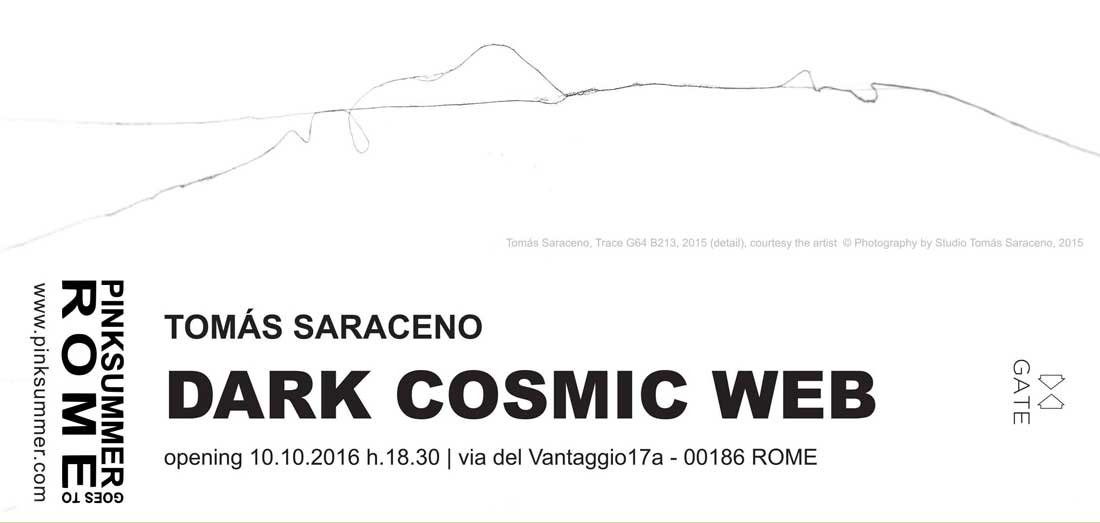Tomas Saraceno – Dark Cosmic Web

Press-release
Dark Cosmic Web, Tomás Saraceno’s solo show at Pinksummer Goes to Rome, via del Vantaggio 17/A a Rome, looks like a gravity lens able to take us along the fibers of dark matter, at which intersection galaxies and worlds clutter. A billions light years wide spiderweb, which invisible filamentous density, assimilated by the artist to the silken web structure, constitutes the largest mass in our universe. A flexible architecture that withholds celestial bodies by resisting to the dark energy, called “quintessence” by astrophysicists in honor of the great Stagirite who used that term to define the rotating ether. A powerful and mysterious anti-gravitational force that seems to push the universe toward an accelerated rarefaction, from “Big Bang” to “Big Strip”, an event that would cause the disintegration of any material concretion, form the macro-cosmos of worlds down to the micro-cosmos of particles, leaving behind just the endless chill and darkness of weird low centrifuge entropy.
Once again, in his exhibition Dark Cosmic Web like in all its work, Saraceno provide us with a model of cosmos through his hybrid spider webs resulting from the subsequent collaboration induced between spiders of different species. By introducing sound in his work, as presented for the first time in his solo show Cosmic Jive (2014) at the contemporary art museum of Villa Croce in Genoa, together with a book gathering contributions from a variety of disciplines, Saraceno transformed the empty space of universe in a pervasive and dense mass, filled with vibrational information. Sounds that disintegrate linear time same as the illusion generated by an interference can be destroyed, as it comes from an elsewhere place such distant in terms of space and time that appears unimaginable. The sounds sampled by Saraceno in order to create his “worlds symphony” are captured by recording, through sophisticated biologist instruments, the sounds produced by spiders that, for different purposes, ranging from hunt to love, pluck their spider webs like an harp, the sounds that are then mixed with those recorded by space agencies.
It was just last February, when Ligo observatory detected for the first time a gravitational wave, a deformation of space-time curve foreseen by Einstein’s theory of general relativity, resulting from the fusion of two black holes, happened between 600 million and 1 billion and 800 million light years ago, which whirling spinning one towards the other reached us in form of a sound, that it has been related to a chirping crescendo, eventually climaxing in the quiet of an achieved act. Sound will make vibrate the exhibition “Dark Cosmic Web” too, taking us off Cartesian coordinates for a moment, like a déjà vu that let us for an instant grasp the multidimensionality of the universe, in which past, present and future are overloaded with necessity in the black hole of contemporary time.
After this introduction that roughly outlines Tomas Saraceno’s solo show at Pinksummer Goes to Rome, it is with great pleasure and gratitude that we let the reader read a text that properly deals with the dark cosmic matters and energies to which the exhibition refers with the anti-retoric harmony and balance that distinguish Saraceno’s work, purposely written on the occasion of Dark Cosmic Web by the astrophysicist Gianluca Masi.
We would like to thank Ilaria Bozzi Ferri and Flavio Ferri, who took us in Rome through Gate project.
The Cosmic Matter, between Lights and Shadows
“All that glisters is not gold”. So it was written in the end of 16th Century on the immortal pages of “The Merchant of Venice” (second act, seventh scene) by Shakespeare (1564-1616), who probably quoted an older saying. That happened half a century after that in Nurnberg the precious “De revolutionibus coelestium” by Copernicus(1473-1543) was printed, a book by which the great Polish left the legacy of his own heliocentric vision of the world. Later on, in the second half of 17th Century, Isaac Newton (1642-1727) with his “Philosophiae Naturalis Principia Mathematica” set in stone the laws of dynamics and the fundamental, so noble in its name, law of universal gravitation.
Around cosmos’ sovereign interaction, the gravitational one, was built the most imposing building of the most famous physics theory in modern world, the one of general relativity, which father Albert Einstein (1879-1955) is a unconfutable icon of our time, indeed a very fashionable man, we would say. Gravity physics, quantum physics, big bang, expansion of the Universe: such topics are, at least verbally, part of our culture. Right within the frame of the general relativity, cosmology constructs, not effortless, its models and draws its own interpreting paths of the physical Universe in which we are dipped.
An evolutionary process, the one of our knowledge of Cosmos, that shall consider new data, new evidences, new cues, every time that more and more audacious and technologically advanced instruments capture some unknown detail. A process that many time forced us, and no doubt it will keep on doing so, to revise our convictions, our theories, in some cases even to the point of dismantling them. Nothing serious, of course. This is the way, the natural way, science goes on: one of its strengths, not a weakness. One could call it its “honesty”.
We did not forget though that in the beginning of this text we did mention the great Shakespeare, a man who is apparently so far away from science, by quoting a fragment that is actually a saying. A saying that stigmatizes the value of shiny things, of what is luminous, because sometimes they are evidently misleading. The quotation, far from being a warning or a suggestion, aims rather to orientate in the right direction the scientific considerations that we are providing as marginal remarks to Tomás Saraceno’s exhibition. About that motto, we are interested in the value commonly attributed to what glisten, metaphor of gold… not always though, as it seems. The great English poet, perhaps catching Esopo’s warning (620 B.C.? – 564 B.C.), remind us that such glitter can dazzle and let us make a blunder. Such a tendency to outvalue things that shine recurs, in more properly astronomical terms, in some words by Sir Frederick William Herschel (1738-1822), the greatest observer astronomer ever, words that became the Royal Astronomical Society’s motto: “Quicquid nitet notandum”, “Whatever shines should be observed”.
Here we go: who knows what our fathers would think today, how would they reformulate their pearls of wisdom if they knew that the majority of the most precious matter that forms the Universe does not glisten, does not spangle, does not shine. It just does not show off like “gravitational gold”, rather camouflaging itself against the black velvet of the cosmic night. It is, simply, dark matter. Is there, but it is not visible, at least not ordinarily, as it remains invisible under the whole electromagnetic spectrum, light included. Nevertheless it manifests itself, in its own way.
The most modern topic of contemporary cosmology was born approximately a century ago. The most convincing prodromes derive from Fritz Zwicky (1898-1974) studies on the heaps of galaxies, which dynamic features seemed to denounce an amount of matter definitely superior to the telescopically visible luminous one. Something invisible, with well perceivable gravitational effects though, that he just called dark matter.
Later on, Vera Rubin (1928) investigations on rotational properties of stars within galaxies turned out to be decisive. After studying spiral galaxies, it emerged that the peripheral stars of those fascinating stellar systems were turning around the nucleus of the hosting galaxy faster than what would be reasonable to expect by looking at the distribution of luminous matter forming that galaxy, as visible through the telescope. It was natural to invoke a halo of dark matter surrounding the galaxy, invisible but able to give the noticed motion to observable stars.
Also, until now we know a couple of galaxies barely formed in terms of ordinary matter, that could therefore mostly made from dark member. The fluctuations in the cosmic background radiation too suggest its existence, same as the relevant case of heaps of galaxies. They tend to organize themselves into massive families, the heaps, that can contain many thousands of galaxies. The mass of such systems can be measured experimentally in various ways, such as the observation of X emission of warm gas present in the heap and the study of the deflection, operated by the heap components, of light coming from the objects behind it. The effect is called gravitational lens and fits within the scenario forecasted by general relativity, envisaging light deflection as a consequence of space-time curving imposed by the existing mass. A theory that has recently been confirmed by the experimental detection of another of its appealing previews, the one of gravity waves.
Our current observations suggest that the dark matter represents approximately the 25 percent of the existing matter in the Universe, against a much more modest 4 percent of ordinary matter, electromagnetically detectable. The remaining approximate 70 percent to be added in order to complete that esteem is the so called dark matter, which would allow to justify the accelerated expansion of the Universe we observed.
If the presence of dark matter seems to convince the majority of scientific community, a big question is left completely unclarified: what is it made from? Hypotheses run one after the other, including black holes, neutron stars and hypothetical not baryonic particles.
The breadth of the topic is such that cold, warm and hot dark matter is technically distinguished. Current cosmology takes as standard model, meaning the one that better summarizes the characteristics of observed Universe, the so-called Lambda-CDM model, where Lamba is the cosmological constant (expression of dark energy) and CDM stands for Cold Dark Matter.
So the dark matter has an essential role in holding those macrostructures we call heaps of galaxies together. At largest scales, they appear as if they were dipped into some sort of filamentous structure, almost like a cosmic spider web, an intricate scaffolding within which, in agreement with calculator simulations, stars and galaxies are formed and develop. Such a spider web is mainly made from dark matter and its meshes are more and more clearly revealed to the indiscreet eye of science.
Along those web threads climbs our wild nature, devoted to knowledge, exploration, discovery. And if what Shakespeare reminded is true, that all that glitters and shines is not ambassador of precious values and revelations, whatever is dark, far from being sinister, can indeed be essential, indispensable to the Universe and fundamental for us in order to decipher its past, present and future plots.
Gianluca Masi
Dottore di Ricerca in Astronomia
Virtual Telescope Project e Planetario di Roma


